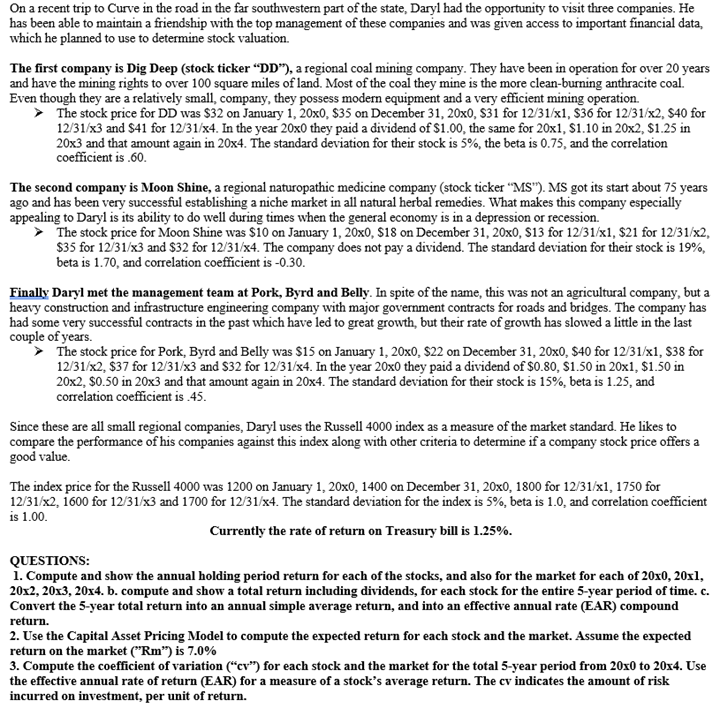TAKE IT TO THE BANK (PART 1)

On a recent trip to Curve in the road in the far southwestern part of the state, Daryl had the opportunity to visit three companies. He has been able to maintain a friendship with the top management of these companies and was given access to important financial data, which he planned to use to determine stock valuation. The first company is Dig Deep (stock ticker "DD"), a regional coal mining company. They have been in operation for over 20 years and have the mining rights to over 100 square miles of land. Most of the coal they mine is the more clean-burning anthracite coal. Even though they are a relatively small, company, they possess modern equipment and a very efficient mining operation. The stock price for DD was $32 on January 1, 20x0, $35 on December 31,200,$31 for 12/31/x1,$36 for 12/31/x2,$40 for 12/31/x3 and $41 for 12/31/x4. In the year 20x0 they paid a dividend of $1.00, the same for 201,$1.10 in 202,$1.25 in 203 and that amount again in 204. The standard deviation for their stock is 5%, the beta is 0.75 , and the correlation coefficient is .60 . The second company is Moon Shine, a regional naturopathic medicine company (stock ticker "MS"). MS got its start about 75 years ago and has been very successful establishing a niche market in all natural herbal remedies. What makes this company especially appealing to Daryl is its ability to do well during times when the general economy is in a depression or recession. The stock price for Moon Shine was $10 on January 1, 20x0, $18 on December 31,200,$13 for 12/31/x1,$21 for 12/31/2, $35 for 12/31/x3 and $32 for 12/31/x4. The company does not pay a dividend. The standard deviation for their stock is 19%, beta is 1.70 , and correlation coefficient is -0.30 . Finally Daryl met the management team at Pork, Byrd and Belly. In spite of the name, this was not an agricultural company, but a heavy construction and infrastructure engineering company with major government contracts for roads and bridges. The company has had some very successful contracts in the past which have led to great growth, but their rate of growth has slowed a little in the last couple of years. The stock price for Pork, Byrd and Belly was $15 on January 1, 20x0, $22 on December 31,200,$40 for 12/31/x1,$38 for 12/31/x2,$37 for 12/31/x and $32 for 12/31/x4. In the year 20x0 they paid a dividend of $0.80,$1.50 in 201,$1.50 in 202,$0.50 in 203 and that amount again in 204. The standard deviation for their stock is 15%, beta is 1.25 , and correlation coefficient is .45 . Since these are all small regional companies, Daryl uses the Russell 4000 index as a measure of the market standard. He likes to compare the performance of his companies against this index along with other criteria to determine if a company stock price offers a good value. The index price for the Russell 4000 was 1200 on January 1,200,1400 on December 31,200,1800 for 12/31/x1,1750 for 12/31/x2,1600 for 12/31/x3 and 1700 for 12/31/x4. The standard deviation for the index is 5%, beta is 1.0 , and correlation coefficient is 1.00 . Currently the rate of return on Treasury bill is 1.25%. QUESTIONS: 1. Compute and show the annual holding period return for each of the stocks, and also for the market for each of 20x0, 20xl, 202,203,204. b. compute and show a total return including dividends, for each stock for the entire 5-year period of time. c. Convert the 5-year total return into an annual simple average return, and into an effective annual rate (EAR) compound return. 2. Use the Capital Asset Pricing Model to compute the expected return for each stock and the market. Assume the expected return on the market ("Rm") is 7.0% 3. Compute the coefficient of variation ("cv") for each stock and the market for the total 5-year period from 20x0 to 20x4. Use the effective annual rate of return (EAR) for a measure of a stock's average return. The cv indicates the amount of risk incurred on investment, per unit of return







